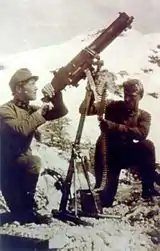Mannlicher M1893
The Mannlicher M1893 (or M93) is a bolt-action rifle that was the standard service rifle of the Kingdom of Romania from 1893 to 1938.[1] The rifle and its 1892 predecessor were the first repeating rifles to be widely issued in the Romanian military.[2] It was later replaced by the Czechoslovak-designed Vz. 24 as the standard service rifle.
| Romanian repeating rifle model 1893 | |
|---|---|
 Rifle and carbine variants. | |
| Type | Bolt-action rifle |
| Place of origin | Austria-Hungary Romania |
| Service history | |
| In service | 1893–1945 |
| Used by | Kingdom of Romania Kingdom of Portugal Austria-Hungary Kingdom of Yugoslavia Czechoslovakia Nazi Germany |
| Wars | Second Balkan War World War I Hungarian–Romanian War Spanish Civil War World War II |
| Production history | |
| Designer | Otto Schönauer, Ferdinand Mannlicher |
| Designed | 1892 |
| Manufacturer | Steyr |
| Produced | 1893–1914 |
| No. built | 195,000 |
| Variants | M1893 Carbine |
| Specifications | |
| Mass | 4.06 kg (9.0 lb) 3.29 kg (7.3 lb) Carbine |
| Length | 1,227 mm (48.3 in) 978 mm (38.5 in) Carbine |
| Barrel length | 725 mm (28.5 in) 450 mm (18 in) Carbine |
| Cartridge | 6.5×53mmR 8×50mmR Mannlicher .22 Long Rifle (1946 trainers) |
| Action | Turning bolt-action |
| Muzzle velocity | 731 m/s (2,400 ft/s) |
| Maximum firing range | 2,100 metres (2,300 yd) |
| Feed system | 5-round en bloc clip, integral box magazine |
Development

.jpg.webp)
Around the year 1890 the Romanian military started its search for a small bore, smokeless powder firearm to replace the breech-loading single-shot Peabody–Martini–Henry M1879. They turned to the nearby Österreichische Waffenfabriksgesellschaft in Steyr, Austria-Hungary where Otto Schönauer was modifying the German Gewehr 1888 rifle. After Ferdinand Mannlicher modified his en-bloc clip feeding system, to allow it to be fed into the rifle regardless of whether the clip was turned up or down, the Model 1892 rifle was ready for testing by the Romanian Army. After some minor improvements, the final variant, the M1893, chambered for the 6.5x53R round also called the "6.5x53.5mmR Romanian", was put into production. Unlike the Austrian-issue Mannlicher M1895 straight-pull bolt-action rifle, the Romanian rifle had a conventional turn-bolt.[3]
The rifle's adoption caused some controversy, as despite the weapon's approval by King Carol I, General Constantin Budișteanu derided the Austrian rifle as un baston ("a walking stick"), and the rifle's bore, smaller than the usual Mannlicher product, caused difficulties in finding compatible gunpowder.[4]
A carbine variant was also introduced, it was 98 centimetres (39 in) long and featured a bent bolt handle. It was used by cavalry and artillery units.
History
Around 195,000 of these rifles were manufactured in total. Some 120,000 rifles and 14,000 carbines were delivered to Romania up to 1914. Remaining assembled rifles were issued to units of the Austro-Hungarian Army at the start of World War I in the original caliber. Unassembled rifles were modified to accommodate the 8×50mmR Mannlicher cartridge and issued to Austo-Hungarian troops. In the First World War many were also captured during the Romanian Campaign and used in the original caliber.[1] The Romanian Mannlicher also saw some service in the Spanish Civil War by Spanish Republicans and captured by the Nationalists. It is unknown how these rifles were obtained.[5]
Portuguese M1896 Mannlicher
The Kingdom of Portugal bought about 12,500 6.5mm Mannlicher rifles and carbines from Steyr, some in 1896, for the Navy and Cavalry, and the remainder in 1898 for the Artillery. These rifles carry "CI" crests for Carlos I of Portugal. The 6.5x53R cartridges were first imported from Georg Roth and later made in Portugal.[6]
In 1946 a few hundred of the Portuguese Mannlichers were adapted to fire the 5.6mm calibre (.22 Rimfire), for training.[6]
References
- "Romanian Mannlicher M1893 Infantry Rifle". hungariae.com. Manowar. 8 December 2011. Retrieved 15 February 2015.
- Bernard Fitzsimons (1978). The Illustrated encyclopedia of 20th century weapons and warfare. Columbia House. p. 1828.
- Spencer C. Tucker (16 December 2013). The European Powers in the First World War: An Encyclopedia. Taylor & Francis. pp. 596–. ISBN 978-1-135-50701-5.
- Jonathan A. Grant (2007). Rulers, Guns, and Money: The Global Arms Trade in the Age of Imperialism. Harvard University Press. pp. 112–. ISBN 978-0-674-02442-7.
- "Foreign Rifles of the Spanish Republic, 1936-1939 – Surplused". Retrieved 29 June 2020.
- http://iaaforum.org/forum3/viewtopic.php?f=8&t=8528
| Wikimedia Commons has media related to Mannlicher M1893. |
